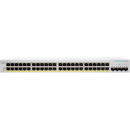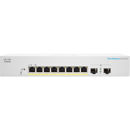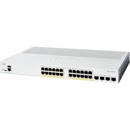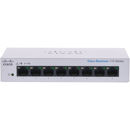
Cisco SG350XG-2F10 12 Port 10GBase-T Stackable Managed Switch
SKU: CISG350XG2F1
This item is no longer available.
Recommended Alternatives
Share:
Overview
Compare
Specs
Protection
Q&A
Questions & Answers
Reviews about this item
Review Summary
Select a plan in the Add Protection section above and purchase with this product by clicking “Add to Cart”.
TRUSTED PROTECTION PLANS, EXCEPTIONAL SERVICE.
Invest In Your Gear and Peace Of Mind!
Accidents happen where life happens. Protect your favorite Adorama products and purchase a protection plan to stay covered from accidental damage, mechanical or electrical failure, and more.
Repair or Replacement
If we can’t fix it, we’ll replace it at no additional cost.
Accidental Damage
Protect your product from drops, spills, and more.
Peace of Mind
Enjoy your gear without fear. We have you covered!
Malfunction Protection
When regular use of your product over time results in mechanical or electrical failure.
Zero Deductible
We will never charge you a deductible after the purchase of a plan.
Customer-Focused Support
Our claims process is simple & easy and our customer service team is happy to help.
Adorama Protect powered by Extend is available for purchase to customers in the United States. Not available for purchase Internationally or in U.S. Territories.
Browse our FAQ
Cisco SG350XG-2F10-K9 Specifications
Performance
Capacity in mpps (64-byte packets): 178.56mpps
Switching Capacity: 240GbpsSpanning Tree Protocol
Standard 802.1d spanning tree support
Fast convergence using 802.1w (Rapid Spanning Tree Protocol [RSTP]), enabled by default
Multiple spanning tree instances using 802.1s (MSTP); 16 instances are supportedPort grouping/link aggregation
Support for IEEE 802.3ad Link Aggregation Control Protocol (LACP)
Up to 8 groups
Up to 8 ports per group with 16 candidate ports for each (dynamic) 802.3ad LAGVLAN
Support for up to 4094 active VLANs simultaneously; port-based and 802.1Q tag-based VLANs; MAC-based VLAN
Management VLAN
Private VLAN with promiscuous, isolated, and community port
Guest VLAN, unauthenticated VLAN, protocol-based VLAN, IP subnet-based VLAN, CPE VLAN
Dynamic VLAN assignment using RADIUS server along with 802.1x client authenticationVoice VLAN
Voice traffic is automatically assigned to a voice-specific VLAN and treated with appropriate levels of QoS. Autovoice capabilities deliver networkwide zero-touch deployment of voice endpoints and call control devices.
Multicast TV VLAN
Multicast TV VLAN allows the single multicast VLAN to be shared in the network while subscribers remain in separate VLANs. This feature is also known as multicast VLAN registration (MVR).
Q-in-Q
VLANs transparently cross over a service provider network while isolating traffic among customers.
GVRP/GARP
Generic VLAN Registration Protocol (GVRP) and Generic Attribute Registration Protocol (GARP) enable automatic propagation and configuration of VLANs in a bridged domain.
Unidirectional Link Detection (UDLD)
UDLD monitors physical connection to detect unidirectional links caused by incorrect wiring or port faults to prevent forwarding loops and blackholing of traffic in switched networks.
DHCP relay at Layer 2
Relay of DHCP traffic to DHCP server in a different VLAN. Works with DHCP option 82.
IGMP (versions 1, 2, and 3) snooping
Internet Group Management Protocol (IGMP) limits bandwidth-intensive multicast traffic to only the requesters; supports 4K multicast groups (source-specific multicasting is also supported).
IGMP querier
IGMP querier is used to support a Layer 2 multicast domain of snooping switches in the absence of a multicast router.
HOL blocking
Head-of-line (HOL) blocking.
IPv4 routing
Wirespeed routing of IPv4 packets
Up to 8K static routes and up to 256 IP interfacesWirespeed IPv6 static routing
Up to 4K static routes and up to 200 IPv6 interfaces
Layer 3 interface
Configuration of Layer 3 interface on physical port, LAG, VLAN interface, or loopback interface
CIDR
Support for classless interdomain routing
VRRP
Virtual Router Redundancy Protocol (VRRP) delivers improved availability in a Layer 3 network by providing redundancy of the default gateway servicing hosts on the network. VRRP versions 2 and 3 are supported. Up to 255 virtual routers are supported.
Policy-based routing (PBR)
Flexible routing control to direct packets to different next hop based on IPv4 or IPv6 ACL
DHCP server
Switch functions as an IPv4 DHCP server serving IP addresses for multiple DHCP pools/scopes
Support for DHCP optionsDHCP relay at Layer 3
Relay of DHCP traffic across IP domains
User Datagram Protocol (UDP) relay
Relay of broadcast information across Layer 3 domains for application discovery or relaying of BOOTP/DHCP packets
Hardware stack
Up to 4 units in a stack. Up to 208 ports managed as a single system with hardware failover
High availability
Fast stack failover delivers minimal traffic loss. Support link aggregation across multiple units in a stack
Plug-&-play stacking config./management
Master/backup for resilient stack control
Autonumbering
Hot swap of units in stack
Ring and chain stacking options, autostacking port speed, flexible stacking port optionsHigh-speed stack interconnects
Cost-effective high-speed 10G fiber and copper interfaces. Support LAG as stacking interconnects for even higher bandwidth.
SSH
SSH is a secure replacement for Telnet traffic. SCP also uses SSH. SSH versions 1 and 2 are supported.
SSL
Secure Sockets Layer (SSL) encrypts all HTTPS traffic, allowing secure access to the browser-based management GUI in the switch.
IEEE 802.1X (authenticator role)
RADIUS authentication and accounting, MD5 hash, guest VLAN, unauthenticated VLAN, single/multiple host mode, and single/multiple sessions.
Supports time-based 802.1X dynamic VLAN assignment.Web-based authentication
Web-based authentication provides network admission control through web browser to any host devices and operating systems.
STP BPDU Guard
A security mechanism to protect the networks from invalid configurations. A port enabled for Bridge Protocol Data Unit (BPDU) Guard is shut down if a BPDU message is received on that port. This avoids accidental topology loops.
STP Root Guard
This prevents edge devices not in the network administrator's control from becoming Spanning Tree Protocol root nodes.
DHCP snooping
Filters out DHCP messages with unregistered IP addresses and/or from unexpected or untrusted interfaces. This prevents rogue devices from behaving as a DHCP server.
IP Source Guard (IPSG)
When IP Source Guard is enabled at a port, the switch filters out IP packets received from the port if the source IP addresses of the packets have not been statically configured or dynamically learned from DHCP snooping. This prevents IP address spoofing.
Dynamic ARP inspection (DAI)
The switch discards ARP packets from a port if there are no static or dynamic IP/MAC bindings or if there is a discrepancy between the source or destination address in the ARP packet. This prevents man-in-the-middle attacks.
IP/MAC/port binding (IPMB)
The preceding features (DHCP snooping, IP Source Guard, and Dynamic ARP inspection) work together to prevent DoS attacks in the network, thereby increasing network availability.
Secure core technology (SCT)
Makes sure that the switch will receive and process management and protocol traffic no matter how much traffic is received.
Secure sensitive data (SSD)
A mechanism to manage sensitive data (such as passwords, keys, and so on) securely on the switch, populating this data to other devices, and secure autoconfig. Access to view the sensitive data as plaintext or encrypted is provided according to the user-configured access level and the access method of the user.
Private VLAN
Private VLAN provides security and isolation between switch ports, which helps ensure that users cannot snoop on other users' traffic; supports multiple uplinks.
Port security
Ability to lock source MAC addresses to ports and limit the number of learned MAC addresses.
RADIUS/TACACS+
Supports RADIUS and TACACS authentication. Switch functions as a client.
RADIUS accounting
The RADIUS accounting functions allow data to be sent at the start and end of services, indicating the amount of resources (such as time, packets, bytes, and so on) used during the session.
Storm control
Broadcast, multicast, and unknown unicast.
DoS prevention
Denial-of-service (DoS) attack prevention.
Multiple user privilege levels in CLI
Level 1, 7, and 15 privilege levels.
ACLs
Support for up to 2K entries.
Drop or rate limit based on source and destination MAC, VLAN ID or IP address, protocol, port, DSCP/IP precedence, TCP/User Datagram Protocol (UDP) source and destination ports, 802.1p priority, Ethernet type, Internet Control Message Protocol (ICMP) packets, Internet Group Management Protocol (IGMP) packets, TCP flag; ACL can be applied on both ingress and egress sides.
Time-based ACLs supported.Priority levels
8 hardware queues
Scheduling
Strict priority and weighted round-robin (WRR)
Class of service
Port based; 802.1p VLAN priority based; IPv4/v6 IP precedence/ToS/DSCP based; DiffServ; classification and remarking ACLs, trusted QoS
Queue assignment based on differentiated services code point (DSCP) and class of service (802.1p/CoS)Rate limiting
Ingress policer; egress shaping and ingress rate control; per VLAN, per port, and flow base; 2R3C policing
Congestion avoidance
A TCP congestion avoidance algorithm is required to minimize and prevent global TCP loss synchronization.
Standards
IEEE 802.3 10BASE-T Ethernet, IEEE 802.3u 100BASE-TX Fast Ethernet, IEEE 802.3ab 1000BASE-T Gigabit Ethernet, IEEE 802.3ad Link Aggregation Control Protocol, IEEE 802.3z Gigabit Ethernet, IEEE 802.3ae 10 Gbit/s Ethernet over fiber for LAN, IEEE 802.3an 10GBase-T 10 Gbit/s Ethernet over copper twisted pair cable, IEEE 802.3x Flow Control, IEEE 802.1D (STP, GARP, and GVRP), IEEE 802.1Q/p VLAN, IEEE 802.1w Rapid STP, IEEE 802.1s Multiple STP, IEEE 802.1X Port Access Authentication
Standards (cont.)
IEEE 802.3af, IEEE 802.3at, IEEE 802.1AB Link Layer Discovery Protocol, IEEE 802.3az Energy Efficient Ethernet, RFC 768, RFC 783, RFC 791, RFC 792, RFC 793, RFC 813, RFC 826, RFC 879, RFC 896, RFC 854, RFC 855, RFC 856, RFC 858, RFC 894, RFC 919, RFC 920, RFC 922, RFC 950, RFC 951, RFC 1042, RFC 1071, RFC 1123, RFC 1141, RFC 1155, RFC 1157, RFC 1213, RFC 1215, RFC 1286, RFC 1350, RFC 1442, RFC 1451, RFC 1493, RFC 1533, RFC 1541, RFC 1542, RFC 1573
Standards (cont.)
IEEE 802.3af, IEEE 802.3at, IEEE 802.1AB Link Layer Discovery Protocol, IEEE 802.3az Energy Efficient Ethernet, RFC 768, RFC 783, RFC 791, RFC 792, RFC 793, RFC 813, RFC 826, RFC 879, RFC 896, RFC 854, RFC 855, RFC 856, RFC 858, RFC 894, RFC 919, RFC 920, RFC 922, RFC 950, RFC 951, RFC 1042, RFC 1071, RFC 1123, RFC 1141, RFC 1155, RFC 1157, RFC 1213, RFC 1215, RFC 1286, RFC 1350, RFC 1442, RFC 1451, RFC 1493, RFC 1533, RFC 1541, RFC 1542, RFC 1573
IPv6
IPv6 host mode IPv6 over Ethernet dual IPv6/IPv4 stack
IPv6 Neighbor and Router Discovery (ND), IPv6 Stateless Address Autoconfiguration, path MTU Discovery
Duplicate Address Detection (DAD) ICMPv6
IPv6 over IPv4 network with ISATAP tunnel support
USGv6 and IPv6 Gold Logo certifiedIPv6 QoS
Prioritize IPv6 packets in hardware
IPv6 ACL
Drop or rate limit IPv6 packets in hardware
IPv6 first hop security
RA guard
ND inspection
DHCPv6 guard
Neighbor binding table (snooping and static entries)
Neighbor binding integrity checkMulticast listener discovery snooping
Deliver IPv6 multicast packets only to the required receivers (MLD v1/2)
IPv6 applications
Web/SSL, Telnet Server/SSH, Ping, Traceroute, SNTP, TFTP, SNMP, RADIUS, Syslog, DNS client, DHCP Client, DHCP Autoconfig, IPv6 DHCP Relay, TACACS
IPv6 RFC supported
RFC 4443 (which obsoletes RFC 2463): ICMPv6
RFC 4291 (which obsoletes RFC 3513): IPv6 address architecture
RFC 4291: IP Version 6 Addressing Architecture
RFC 2460: IPv6 Specification
RFC 4861 (which obsoletes RFC 2461): Neighbor Discovery for IPv6IPv6 RFC supported (cont.)
RFC 4862 (which obsoletes RFC 2462): IPv6 Stateless Address Autoconfiguration
RFC 1981: Path MTU Discovery
RFC 4007: IPv6 Scoped Address Architecture
RFC 3484: Default address selection mechanism
RFC 5214 (which obsoletes RFC 4214): ISATAP tunneling
RFC 4293; MIB IPv6: Textual Conventions and General Group
RFC 3595; Textual Conventions for IPv6 Flow LabelWeb user interface
Built-in switch configuration utility for easy browser-based device configuration (HTTP/HTTPS).
Supports simple and advanced mode, configuration, wizards, customizable dashboard, system maintenance, monitoring, online help, and universal search.SNMP
SNMP versions 1, 2c, and 3 with support for traps, and SNMP v3 User-based Security Model (USM)
RMON
Embedded RMON software agent supports 4 RMON groups (history, statistics, alarms, and events) for enhanced traffic management, monitoring, and analysis.
IPv4 and IPv6 dual stack
Coexistence of both protocol stacks to ease migration.
Firmware upgrade
Web browser upgrade (HTTP/HTTPS) and TFTP and SCP
Upgrade can be initiated through console port as well
Dual images for resilient firmware upgradesPort mirroring
Traffic on a port or LAG can be mirrored to another port for analysis with a network analyzer or RMON probe. Up to 8 source ports can be mirrored to one destination port.
VLAN mirroring
Traffic from a VLAN can be mirrored to a port for analysis with a network analyzer or RMON probe. Up to 8 source VLANs can be mirrored to one destination port.
Flow-based redirection and mirroring
Redirect or mirror traffic to a destination port or mirroring session based on flow.
Remote switch port analyzer (RSPAN)
Traffic can be mirrored across Layer 2 domain to a remote port on a different switch for easier troubleshooting.
sFlow agent
Switch can export sFlow sample to external collectors. sFlow provides visibility into network traffic down to flow level.
DHCP (options 12, 66, 67, 82, 129 & 150)
DHCP options facilitate tighter control from a central point (DHCP server), to obtain IP address, auto configuration (with configuration file download), DHCP Relay, and host name.
Auto configuration w/ SCP file download
Enables secure mass deployment with protection of sensitive data.
Text-editable configs
Config files can be edited with a text editor and downloaded to another switch, facilitating easier mass deployment.
Smartports
Simplified configuration of QoS and security capabilities.
Auto Smartports
Automatically applies the intelligence delivered through the Smartports roles to the port based on the devices discovered over Cisco Discovery Protocol or LLDP-MED. This facilitates zero-touch deployments.
Secure copy (SCP)
Securely transfer files to and from the switch.
Textview CLI
Scriptable CLI. A full CLI as well as a menu CLI are supported.
Cloud services
Support for Cisco Active Advisor.
Localization
Localization of GUI and documentation into multiple languages.
Login banner
Configurable multiple banners for web as well as CLI.
Time-based port operation
Link up or down based on user-defined schedule (when the port is administratively up).
Other management
Traceroute; single IP management; HTTP/HTTPS; SSH; RADIUS; port mirroring; TFTP upgrade; DHCP client; Simple Network Time Protocol (SNTP); Xmodem upgrade; cable diagnostics; Ping; syslog; Telnet client; SSH client; automatic time settings from Management Station.
Energy detect
Automatically turns power off on RJ-45 port when detecting link down. Active mode is resumed without loss of any packets when the switch detects the link is up.
Cable length detection
Adjusts the signal strength based on the cable length. Reduces the power consumption for shorter cables.
EEE compliant (802.3az)
Supports IEEE 802.3az on all 10 Gigabit copper ports.
Disable port LEDs
LEDs can be manually turned off to save on energy.
Jumbo frames
Frame sizes up to 9K bytes. The default MTU is 2K.
MAC table
64K addresses.
Bonjour
The switch advertises itself using the Bonjour protocol.
LLDP (802.1ab) with LLDP-MED extensions
Link Layer Discovery Protocol (LLDP) allows the switch to advertise its identification, configuration, and capabilities to neighboring devices that store the data in a MIB. LLDP-MED is an enhancement to LLDP that adds the extensions needed for IP phones.
Cisco Discovery Protocol
The switch advertises itself using the Cisco Discovery Protocol. It also learns the connected device and its characteristics using Cisco Discovery Protocol.
Power consumption (worst case)
Green Power (Mode): EEE, Energy Detect, Short Reach
System Power Consumption: 110V=84.3W, 220V=84.6W
Heat Dissipation: 288.67BTU/hrPorts
10x 10 Gigabit Ethernet 10GBase-T copper port
2x 10 Gigabit Ethernet SFP+ (dedicated)
1x Gigabit Ethernet management portConsole port
Cisco Standard RJ45 console port
OOB management port
Dedicated Gigabit management port for out-of-band management on SG350XG models
USB slot
USB Type-A slot on the front panel of the switch for easy file and image management
Buttons
Reset button
Cabling type
Unshielded twisted pair (UTP) Category 5 or better; fiber options (SMF and MMF); coaxial SFP+
LEDs
System, master, stack ID, link/speed per port
Flash
256MB
CPU
800MHz (dual-core) ARM
CPU memory
512MB
Packet buffer
2MB
Minimum Requirements
Web browser: Mozilla Firefox version 8 or later; Microsoft Internet Explorer version 7 or later, Safari, Chrome
Category 6a Ethernet network cable for 10 Gig speeds at up to 100m
TCP/IP, network adapter, and network operating system (such as Microsoft Windows, Linux, or Mac OS X) installedPower
100 - 240V 47 - 63 Hz, internal, universal
Certification
UL (UL 60950), CSA (CSA 22.2), CE mark, FCC Part 15 (CFR 47) Class A
Operating temperature
32 to 122deg. F (0 to 50deg. C)
Storage temperature
-4 to 158deg. F (-20 to 70deg. C)
Operating humidity
10% to 90%, relative, noncondensing
Storage humidity
10% to 90%, relative, noncondensing
Fan (Number)
4
Acoustic Noise
0 to 30deg. C (32 to 86deg. F): 38.9dB
50deg.C: 49.7dBMTBF
291,863 Hours at 50deg. C
Dimensions (WxHxD)
440 x 44 x 350mm (17.32 x 1.73 x 13.78")
Weight
4.03kg (8.88 lbs)
UPC Code
882658731129
About Cisco SG350XG-2F10-K9
10-Gigabit Managed Switches That Provide the Ideal Combination of Features and Affordability
To stay ahead in a competitive marketplace, small businesses need to make every dollar count. That means getting the most value from your technology investments, but it also means making sure that employees have fast, reliable access to the business tools and information they need. Every minute an employee waits for an unresponsive application - and every minute your network is down - has an impact on your bottom line.
The importance of maintaining a strong and dependable business network only grows as your business adds more employees, applications and network complexity. When your business needs advanced security and features but value is still a top consideration, you're ready for the new generation of Cisco Small Business managed switches: the Cisco 350X Series.
Cisco 350X Series Stackable Managed Switches
The Cisco 350X Series Stackable Managed Switches are a new line of stackable managed Ethernet switches that provide the rich capabilities you need to support a more demanding network environment at a very affordable price. The SG350X models provide 24 or 48 ports of Gigabit Ethernet connectivity with 10 Gigabit uplinks. The Cisco 350XG models provide 12, 24 or 48 ports of all 10 Gigabit Ethernet, providing a solid foundation for your current business applications as well as those you are planning for the future. In addition, these switches are easy to deploy and manage without a large IT staff. The SG350X platforms are Cisco's most cost-effective platforms with 10 Gigabit Ethernet and stacking.
Cisco 350X Series switches are designed to protect your technology investment as your business grows. Unlike switches that claim to be stackable but have elements that are administered and troubleshot separately, the Cisco 350X Series provides true stacking capability, allowing you to configure, manage and troubleshoot multiple physical switches as a single device and more easily expand your network.
A true stack delivers a unified data and control plane, in addition to management plane, providing flexibility, scalability and ease of use because the stack of units operate as a single entity constituting all the ports of the stack members. The switches also protect your technology investment with an enhanced warranty, dedicated technical support and the ability to upgrade equipment in the future. Overall, the Cisco 350X Series provides the ideal technology foundation for a growing business.
What's in the box:
- Cisco SG350XG-2F10 12 Port 10GBase-T Stackable Managed Switch
- Power Cord
- Mounting Kit
- Serial Cable
- Quick Start Guide
- Cisco Lifetime Limited Warranty



